Stuart Jeanne Bramhall's Blog: The Most Revolutionary Act , page 134
January 15, 2025
Of Course All Climate Scientists Agree When You Censor the Ones That Don’t
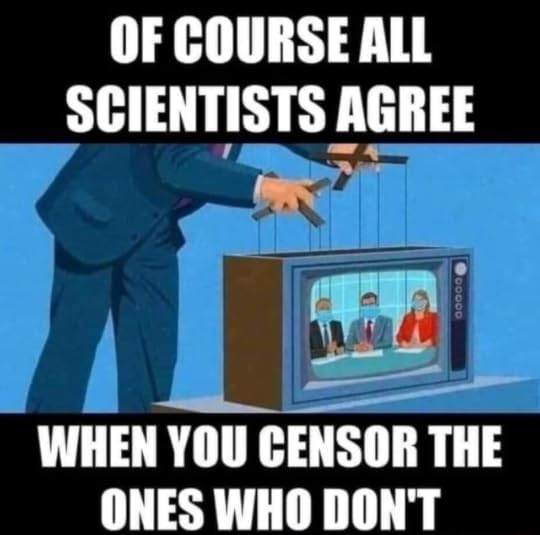 by Ron Clutz
by Ron Clutz
The most recent case of climatists’ bad behavior is the retraction of a peer-reviewed paper analyzing the properties of CO2 as an IR active gas, concluding that additional levels of atmospheric CO2 will have negligible effect on temperatures. From the Daily Sceptic:
Another important paper taking issue with the ‘settled’ climate narrative has been cancelled following a report in the Daily Sceptic and subsequent reposts that went viral across social media. The paper discussed the atmospheric ‘saturation’ of greenhouse gases such as carbon dioxide and argued that higher levels will not cause temperatures to rise. The work was led by the widely-published Polish scientist Dr. Jan Kubicki and appeared on Elsevier’s ScienceDirect website in December 2023. The paper has been widely discussed on social media since April 2024 when the Daily Sceptic reported on the findings. Interest is growing in the saturation hypothesis not least because it provides a coherent explanation for why life and the biosphere grew and often thrived for 600 million years despite much higher atmospheric levels of greenhouse gases. Alas for control freaks, it also destroys the science backing for the Net Zero fantasy.
Below are some comments responding to a Quora question, text in italics with my bolds and added images:
What are some reasons why some people do not believe in climate change or global warming despite scientific evidence? Is there any additional information that could help us understand their perspective?
Answer from Mike Jonas, M.A. in Mathematics, Oxford University, UK,
Good scientists do not lie and cheat to protect their science, they are happy to discuss their evidence and their findings, and they always understand that everything needs to be replicable and verifiable.
When Climategate erupted on the scene, and the climate scientists behind the man-made global warming narrative were found to have lied and cheated, all honest scientists thought that would be the end of it. Instead, what happened was that those climate scientists closed ranks and carried on, supported by a massive amount of government (ie, the public’s) money. One of the first things they did was to deflect Climategate by saying the emails involved had been hacked so should be ignored, but some of the people involved confirmed that all of the emails really were genuine.
It has been about 15 years since Climategate, and study after study has shown virtually all of the components of the man-made global warming narrative to be incorrect, even that none of the computer models used by the IPCC are fit for purpose,
And yet they maintained their closed ranks, and the government money kept pouring in.
Did you know that the IPCC does not do any research (please do check that, on their web page About – IPCC they state “The IPCC does not conduct its own research”). It is, as its name says, an inter-governmental organisation, and it is run by and for governments. They say lots of persuasive sciency things, but the simple fact is that they cherry-pick and corrupt the science to achieve their ends. Regrettably, almost all the scientific societies are on the gravy train too. This is part of what the highly respected physicist Professor Hal Lewis said in his resignation letter to the American Physical Society (APS):
It is of course, the global warming scam, with the (literally) trillions of dollars driving it, that has corrupted so many scientists, and has carried APS before it like a rogue wave. It is the greatest and most successful pseudoscientific fraud I have seen in my long life as a physicist. Anyone who has the faintest doubt that this is so should force himself to read the ClimateGate documents, which lay it bare.
I don’t believe that any real physicist, nay scientist, can read that stuff without revulsion. I would almost make that revulsion a definition of the word scientist.
[…]
It is not a known fact by how much the Earth’s atmosphere will warm in response to this added carbon dioxide. The warming numbers most commonly advanced are created by climate computer models built almost entirely by scientists who believe in catastrophic global warming. The rate of warming forecast by these models depends on many assumptions and engineering to replicate a complex world in tractable terms, such as how water vapor and clouds will react to the direct heat added by carbon dioxide or the rate of heat uptake, or absorption, by the oceans.
We might forgive these modelers if their forecasts had not been so consistently and spectacularly wrong. From the beginning of climate modeling in the 1980s, these forecasts have, on average, always overstated the degree to which the Earth is warming compared with what we see in the real climate.
For instance, in 1994 we published an article in the journal Nature showing that the actual global temperature trend was “one-quarter of the magnitude of climate model results.” As the nearby graph shows, the disparity between the predicted temperature increases and real-world evidence has only grown in the past 20 years.
“Consensus” science that ignores reality can have tragic consequences if cures are ignored or promising research is abandoned. The climate-change consensus is not endangering lives, but the way it imperils economic growth and warps government policy making has made the future considerably bleaker. The recent Obama administration announcement that it would not provide aid for fossil-fuel energy in developing countries, thereby consigning millions of people to energy poverty, is all too reminiscent of the Sick and Health Board denying fresh fruit to dying British sailors.
Another questioner, Dr. Koonin was undersecretary for science in the Energy Department during President Barack Obama’s first term and is currently director of the Center for Urban Science and Progress at New York University. His previous positions include professor of theoretical physics and provost at Caltech, as well as chief scientist of BP, where his work focused on renewable and low-carbon energy technologies.
But—here’s the catch—those questions are the hardest ones to answer. They challenge, in a fundamental way, what science can tell us about future climates.
Firstly, even though human influences could have serious consequences for the climate, they are physically small in relation to the climate system as a whole. For example, human additions to carbon dioxide in the atmosphere by the middle of the 21st century are expected to directly shift the atmosphere’s natural greenhouse effect by only 1% to 2%. Since the climate system is highly variable on its own, that smallness sets a very high bar for confidently projecting the consequences of human influences.
A second challenge to “knowing” future climate is today’s poor understanding of the oceans. The oceans, which change over decades and centuries, hold most of the climate’s heat and strongly influence the atmosphere. Unfortunately, precise, comprehensive observations of the oceans are available only for the past few decades; the reliable record is still far too short to adequately understand how the oceans will change and how that will affect climate.
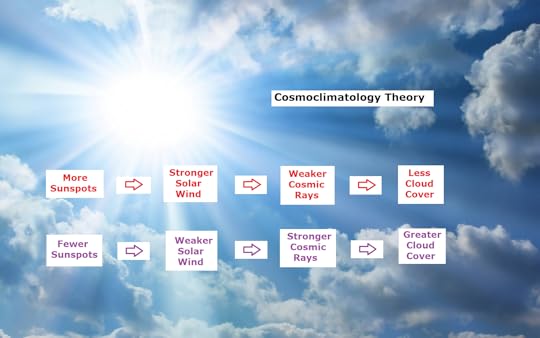
A third fundamental challenge arises from feedbacks that can dramatically amplify or mute the climate’s response to human and natural influences. One important feedback, which is thought to approximately double the direct heating effect of carbon dioxide, involves water vapor, clouds and temperature.
Climate Science Is Not Settled
Another group questioning what some consider “settled science”:
Claude Allegre, former director of the Institute for the Study of the Earth, University of Paris;J. Scott Armstrong, cofounder of the Journal of Forecasting and the International Journal of Forecasting;Jan Breslow, head of the Laboratory of Biochemical Genetics and Metabolism, Rockefeller University;Roger Cohen, fellow, American Physical Society;Edward David, member, National Academy of Engineering and National Academy of Sciences;William Happer, professor of physics, Princeton;Michael Kelly, professor of technology, University of Cambridge, U.K.;William Kininmonth, former head of climate research at the Australian Bureau of Meteorology;Richard Lindzen, professor of atmospheric sciences, MIT;James McGrath, professor of chemistry, Virginia Technical University;Rodney Nichols, former president and CEO of the New York Academy of Sciences;Burt Rutan, aerospace engineer, designer of Voyager and SpaceShipOne;Harrison H. Schmitt, Apollo 17 astronaut and former U.S. senator;Nir Shaviv, professor of astrophysics, Hebrew University, Jerusalem;Henk Tennekes, former director, Royal Dutch Meteorological Service;Antonio Zichichi, president of the World Federation of Scientists, Geneva.Although the number of publicly dissenting scientists is growing, many young scientists furtively say that while they also have serious doubts about the global-warming message, they are afraid to speak up for fear of not being promoted—or worse. They have good reason to worry. In 2003, Dr. Chris de Freitas, the editor of the journal Climate Research, dared to publish a peer-reviewed article with the politically incorrect (but factually correct) conclusion that the recent warming is not unusual in the context of climate changes over the past thousand years. The international warming establishment quickly mounted a determined campaign to have Dr. de Freitas removed from his editorial job and fired from his university position. Fortunately, Dr. de Freitas was able to keep his university job.
[…]
[[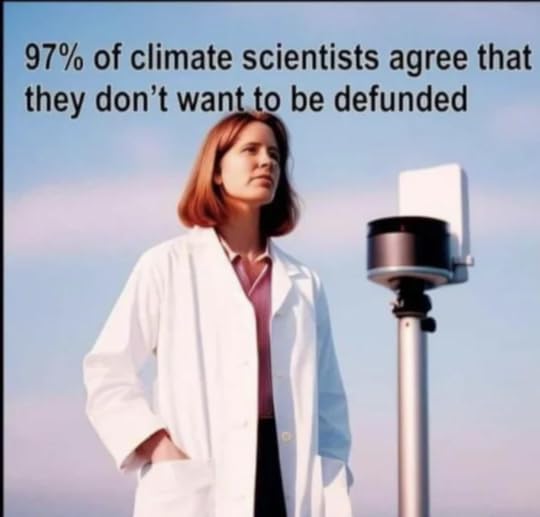
[…]
Via https://rclutz.com/2025/01/14/good-reasons-to-distrust-climatists/
No Proof MMR Vaccine Is ‘Safer’ than Measles, Mumps or Rubella Infection
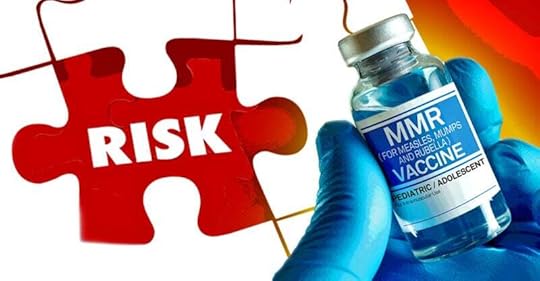
The risk of permanent disability or death from the MMR vaccine may be greater than the risk posed by measles, mumps or rubella infection because large enough vaccine safety studies haven’t been done, according to a collection of new documents released by Physicians for Informed Consent (PIC).
The collection includes disease information statements for measles, mumps and rubella, and a vaccine risk statement for the MMR vaccine.
According to the Mayo Clinic, measles is a viral infection typically accompanied by a skin rash, fever, cough, runny nose, sore throat, inflamed eyes and tiny white spots on the inner cheek.
Mumps and rubella also are viral infections. According to PIC, all three viral infections typically resolve on their own with proper rest and hydration in almost all cases.
Dr. Shira Miller, PIC’s founder and president, told The Defender, “The main takeaway is that the MMR vaccine has not been proven safer than measles, mumps and rubella.”
PIC is a nonprofit that delivers data to doctors and the public so they can “evaluate the data on infectious diseases and vaccines objectively, and voluntarily engage in informed decision-making about vaccination.”
Miller explained that the MMR vaccine clinical trials didn’t include enough subjects to be able to prove that the risk of permanent disability or death from the vaccine is less than the risk of permanent disability or death from measles, mumps or rubella.
The number of measles, mumps or rubella infections that result in permanent disability or death is so low that researchers would need to have at least 50,000 subjects in a clinical trial to be able to show that the vaccine is safer than the disease.
The MMR vaccine’s clinical trials fall very short of that benchmark, according to PIC’s statement on MMR vaccine risk.
Prelicensure clinical trials for vaccines, including the MMR shot, are “relatively small and usually last no longer than a few years,” according to the Centers for Disease Control and Prevention’s (CDC) 2024 “Manual for the Surveillance of Vaccine-Preventable Diseases.”
The 2024 edition of the CDC manual doesn’t specify exactly how many subjects are in these “relatively small” trials. However, the 2011 edition stated that “relatively small” meant that such trials are “usually limited to a few thousand subjects.”
The rate of disability or death among healthy children from any of those three diseases is incredibly rare. PIC wrote:
“For children under age 10 at normal risk (i.e., with normal levels of vitamin A and infected after birth), the pre-vaccine annual risk of death or permanent disability from measles, mumps, and rubella respectively was 1 in 1 million, 1 in 1.6 million, and 1 in 2.1 million. …
“Therefore, the cumulative annual risk of a fatal or permanently disabling case of any of those diseases was about 1 in 500,000, and the risk over a 10-year span was 1 in 50,000.”
In other words, clinical trials would need at least 50,000 subjects to detect one case of death or disability from a measles, mumps or rubella infection.
Meanwhile, no safety studies on the MMR vaccine have been done that looked for possible genetic mutations, impaired fertility or cancer, according to the product’s package insert.
Also, seizures from the MMR vaccine occur five times more often than measles-related seizures.
Dr. Liz Mumper, a pediatrician, praised PIC for releasing the collection of data on measles, mumps and rubella, and on the MMR vaccine.
“Most parents have not had access to the information contained in the thoughtful analysis done by Physicians for Informed Consent. Parents should recognize that the risk of bad outcomes from a measles infection — if their child lives in a developed country with clean water and is not immune-deficient — is extraordinarily rare, as PIC reports.”
Unfortunately, she added, recent U.S. media reports “sensationalized” the risks of measles.
What’s typically missing from measles media reports
PIC’s statement on measles cited numerous facts commonly overlooked in many media reports on measles outbreaks, including:
The U.S. measles mortality rate dropped dramatically before a measles vaccine was introduced in 1963.Immunity from the MMR vaccine wanes so that by age 15, roughly 60% of vaccinated children are susceptible to subclinical measles virus infections.Studies have suggested a link between a naturally acquired measles infection and a reduced risk of Hodgkin’s and non-Hodgkin’s lymphomas.Studies also suggested a link between a naturally acquired measles infection and a lower risk of asthma, eczema and hay fever.Malnutrition — particularly vitamin A deficiency — is a primary cause of over 100,000 measles deaths in underdeveloped countries.Mumper said that the risk of bad outcomes from a measles infection drastically declined with improved public health and better nutrition long before MMR vaccines were available.
“The risk of bad outcomes has always been more for children in developing countries who are more likely to have nutritional deficiencies including vitamin A and lack access to clean water,” Mumper added.
[…]
Via https://childrenshealthdefense.org/defender/measles-mumps-rubella-infection-mmr-vaccine-risk/
2025: The Year the Federal Debt Bubble Bursts
While nothing is certain, I think we can count on radical changes in 2025.
Navigating new paradigms in finance, geopolitics, and energy will be crucial for investors.
A primary focus in my research is to put together the pieces to reveal the true Big Picture and get positioned in unstoppable investment trends ahead of the crowd with smart speculations.
I’m more interested in getting the Big Picture right than gambling on short-term trades in rigged markets.
Understanding the Big Picture has always been essential. But given the scale of changes looming, I can’t think of another year in living memory where it will be more critical than in 2025.
Of particular importance is the US governments financial situation, which has been gradually deteriorating for decades. It’s not surprising that many people are complacent. They’ve long heard about the debt problem, and nothing has happened.
However, I think there’s an excellent chance that 2025 could be the year we see a paradigm shift, shattering conventional mental and financial models for the federal debt.
A crucial tipping point was reached in 2024 when the interest expense on the federal debt exceeded the defense budget for the first time. It’s on track to exceed Social Security and become the BIGGEST item in the federal budget.
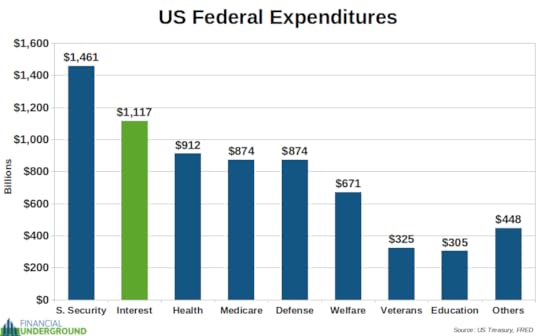
Historian Niall Ferguson summed it up nicely:
“Any great power that spends more on debt service (interest payments on the national debt) than on defense will not stay great for very long.
True of Habsburg Spain, true of ancien régime France, true of the Ottoman Empire, true of the British Empire, this law is about to be put to the test by the US beginning this very year.”
The US government will soon have to choose to:
Cut defense spending amid the most chaotic geopolitical period since WW2.Default on its promises regarding Social Security, Medicare, Veterans’ Benefits, and welfare generally.Though it may try, the US government cannot continue to pay for entitlements and defense even if their current levels stay flat into the future. But they won’t stay flat. Both are set to grow significantly in the years ahead.
Tens of millions of Baby Boomers—about 22% of the population—will enter retirement in the coming years. Cutting Social Security and Medicare is a sure way to lose an election.
With the most precarious geopolitical situation since World War 2, defense spending is unlikely to be cut. Instead, defense spending is all but certain to increase.
Former Secretary of Defense Robert Gates recently said: “Barely staying even with inflation or worse is wholly inadequate. Significant additional resources for defense are necessary and urgent.”
In short, efforts to reduce expenditures will be meaningless unless it becomes politically acceptable to make chainsaw-like cuts to entitlements, national defense, and welfare while reducing the national debt to lower the interest cost.
In other words, the US would need a leader who—at a minimum—returns the federal government to a limited Constitutional Republic, closes the 128 military bases abroad, ends entitlements, kills the welfare state, and repays a large portion of the national debt.
However, that’s a completely unrealistic fantasy. It would be foolish to bet on that happening.
That’s why Elon Musk and DOGE are being set up for failure.
The Bottom LineThe government cannot even slow the spending growth rate, let alone cut it.
Expenditures have nowhere to go but up—way up.
The most likely outcome is that the US will try to have its cake and eat it too by paying for both growing defense and domestic obligations via currency debasement.
That’s why I’m confident that ever-increasing currency debasement is the inevitable outcome of the US government’s debt spiral.
It’s a self-perpetuating doom loop from which they cannot escape.
It’s like being on a runaway train with no brakes.
I suspect 2025 will be the year this becomes evident as previous mainstream conceptions about the national debt collapse.
“We owe it to ourselves.”“Deficits don’t matter.”“Treasuries are risk-free return.”“The national debt is sustainable as long as we can print money.”“The US will never default.”These have long been ridiculous tropes that many investors believed.
2025 could be the year the people who believe this nonsense receive a harsh reality check.
As this trend unfolds, I expect the rate of debasement will far exceed the nominal yield that Treasuries and most other bonds will offer.
That means people will look for alternatives to park their savings to preserve their purchasing power.
Instead of parking their savings in Treasuries, I believe people, companies, and countries will increasingly park their savings in gold. It’s already happening in a big way.
[…]
Via https://internationalman.com/articles/2025-the-year-the-federal-debt-bubble-bursts/
What They Don’t Teach You in School About Vikings
Normans in Italy/Wars of the Lombards
History Time (2020)
Film Review
The Lombards were a Germanic tribe from East of the Rhine that migrated to southern Italy shortly after the Goths, Vandals and Visigoths occupied northern Italy and Spain. During the mid 6th century, the Lombards served as mercenaries under Attila the Hun, and the Byzantine Emperor Justinian hired them to drive the Ostrogoths out of Italy. They were allowed to settle the land previously held by the Ostrogoths (throughout most of Italy) but were never as unified as the Franks in France or the Visigoths in Spain. They adopted the Latin language and much of the infrastructure surviving from the Western Roman Empire.
Charlemagne conquered northern Italy for the Holy Roman Empire in 800, and the Byzantine Empire conquered and settled southern Italy in the early 11th century. Although Capua retained its independence, Lombardy, Salerno and became self-governing principalities under under Byzantine rule. Beginning in the 11th century, a Viking (Norman) campaign in southern Italy and Sicily gradually brought these territories under Norman rule.
Following the fall of Rome, the Byzantine Empire frequently hired Norman knights and foot soldiers as mercenaries. During their invasion of Southern Italy, Sicily and England the Normans incorporated innovative Byzantine military technology not previously seen in Europe. See Byzantine Influence on Norman Weapons
Timeline of Norman invasions:
8th century AD – Viking raids on England, Scotland, Ireland and France (as well as other parts of northern European begin.
791 AD – Vikings (aka Normans) begin major assaults on west coast of Normandy, establishing the Viking Duchy of Normandy in 911
861 AD – Viking invaders seize and settle Novgorod in northern Russia
885 AD – Norman invaders launch attack on Paris
1040 AD – Holy Roman Empire troops supported by Norman mercenaries and Lombard rebels march against the Byzantine army in Padua. Skirmishes between Lombard rebels, at times aided by Norman mercenaries, and Byzantine forces continue intermittently.
1053 AD – Battle of Civitat results in Norman victory over coalition of Byzantine troops and troops representing, leaving the Normans in control of Lombardy.*
1061 AD – Viking princes Roger and Robert Giscard first invade Sicily and consolide their control of the Island in 1090 AD (see What You Never Learned About in School: The Normn Conquest of Sicily).
1066-1671 AD – the Norman prince William the Conqueror invades and conquers England.
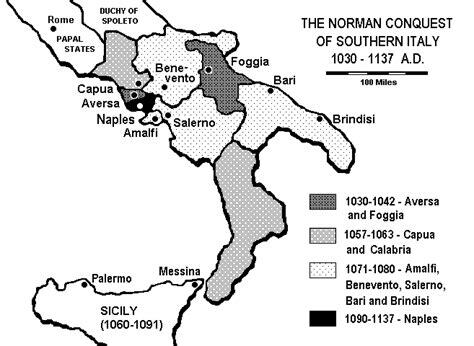
January 14, 2025
The CDC, Palantir and Personal Health Surveillance
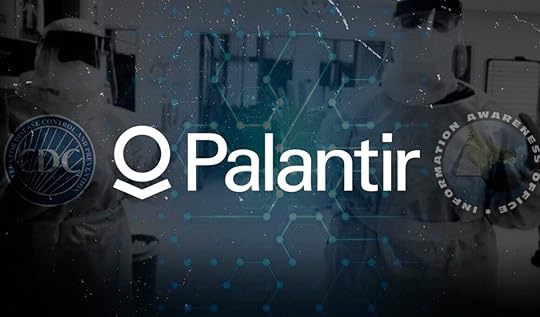
The CDC’s Center for Forecasting and Outbreak Analytics (CFA) has partnered with the CIA-linked Palantir to cement the public-private model of invasive surveillance in “public health,” all while pushing the U.S. national security state and Silicon Valley even closer together.
The Pentagon and Silicon Valley are in the midst of cultivating an even closer relationship as the Department of Defense (DoD) and Big Tech companies seek to jointly transform the American healthcare system into one that is “artificial intelligence (AI)-driven.” The alleged advantages of such a system, espoused by the Army itself, Big Tech and Pharma executives as well as intelligence officers, would be unleashed by the rapidly developing power of so-called “predictive medicine,” or “a branch of medicine that aims to identify patients at risk of developing a disease, thereby enabling either prevention or early treatment of that disease.”
This will apparently be achieved via mass interagency data sharing between the DoD, the Department of Health and Human Services (HHS) and the private sector. In other words, the military and intelligence communities, as well as the public and private sector elements of the US healthcare system, are working closely with Big Tech to “predict” diseases and treat them before they occur (and even before symptoms are felt) for the purported purpose of improving civilian and military healthcare.
This cross-sector team plans to deliver this transformation of the healthcare system by first utilizing and sharing the DoD’s healthcare dataset, which is the most “comprehensive…in the world.” It seems, however, based on the programs that already utilize this predictive approach and the necessity for “machine learning” in the development of AI technology, that this partnership would also massively expand the breadth of this healthcare dataset through an array of technologies, methods and sources.
Yet, if the actors and institutions involved in lobbying for and implementing this system indicate anything, it appears that another—if not primary—purpose of this push towards a predictive AI-healthcare infrastructure is the resurrection of a Defense Advanced Research Projects Agency (DARPA)-managed and Central Intelligence Agency (CIA)-supported program that Congress officially “shelved” decades ago. That program, Total Information Awareness (TIA), was a post 9/11 “pre-crime” operation which sought to use mass surveillance to stop terrorists before they committed any crimes through collaborative data mining efforts between the public and private sector.
While the “pre-crime” aspect of TIA is the best known component of the program, it also included a component that sought to use public and private health and financial data to “predict” bioterror events and pandemics before they emerge. This was TIA’s “Bio-Surveillance” program, which aimed to develop “necessary information technologies and a resulting prototype capable of detecting the covert release of a biological pathogen automatically, and significantly earlier than traditional approaches.” Its architects argued it would achieve this by “monitoring non-traditional data sources” including “pre-diagnostic medical data” and “behavioral indicators.” While ostensibly created to thwart “bioterror” events, the program also sought to create algorithms for identifying “normal” disease outbreaks, essentially seeking to automate the early detection of either biological attacks or natural pathogen outbreaks, ranging from pandemics to presumably other, less severe disease events.
 Bio-Surveillance graph from TIA – SourceAs previously reported by Unlimited Hangout, after TIA was terminated by Congress, it largely survived by privatizing its projects into the company known as Palantir, founded by Paypal co-founder Peter Thiel and some of his associates from his time at Stanford University. Notably, the initial software used to create Palantir’s first product was Paypal’s anti-fraud algorithm. While Palantir, for most of its history, has not overtly sought to resurrect the TIA Bio-surveillance program, that has now changed in the wake of the Covid-19 crisis.
Bio-Surveillance graph from TIA – SourceAs previously reported by Unlimited Hangout, after TIA was terminated by Congress, it largely survived by privatizing its projects into the company known as Palantir, founded by Paypal co-founder Peter Thiel and some of his associates from his time at Stanford University. Notably, the initial software used to create Palantir’s first product was Paypal’s anti-fraud algorithm. While Palantir, for most of its history, has not overtly sought to resurrect the TIA Bio-surveillance program, that has now changed in the wake of the Covid-19 crisis.
In late 2022, Palantir announced that it and the Centers for Disease Control and Prevention (CDC) would continue their ongoing work to “plan, manage and respond to future outbreaks and public health incidents” by streamlining its existing biosurveillance programs “into a singular, efficient vehicle” to support the CDC’s “Common Operating Picture.” This “Common Operating Picture” aims to secure “strong collaboration across the federal government, jurisdictional health departments, private sector entities, and other key health partners.”
The CDC and Palantir publicized this partnership just months after the CDC announced the creation of the its Center for Forecasting and Outbreak Analytics (CFA). This office now plans to expand biosurveillance infrastructure via public-private partnerships across the country to ensure that local communities constantly supply federal agencies with a steady stream of bio-data to develop AI-generated pandemic “forecasts,” or viral outbreak predictions, that will inform pandemic policy measures during pandemics and before they even occur, theoretically before even a single person dies of a particular contagion.
On the surface level, such a mission might sound as though it would serve public health; if government and private institutions can collaborate to prevent pandemics before they happen, well then, why not? Yet, again, the origins of Palantir demonstrate that these “healthcare” surveillance policy measures actually work completely in tandem with the deeper, aforementioned “pre-crime” national security goal of TIA, which powerful forces have been slowly implementing for decades. The ultimate goal it seems, is to usher in a new, even more invasive surveillance paradigm where both the external environment and the public’s internal environment (i.e. our bodies) are monitored for “errant” signals.
Palantir’s founder and largest shareholder, Peter Thiel, incorporated the company in the immediate aftermath of Total Information Awareness’s (TIA) shut down—which resulted from prominent media and political criticism—with significant funding from the CIA’s venture capital arm, In-Q-Tel, as well as direct guidance from the CIA on its product development. As Unlimited Hangout detailed in its investigation into Donald Trump’s 2024 running-mate J.D. Vance and his rise to MAGA stardom, Thiel and Palantir co-founder Alex Karp met with the head of TIA at DARPA, John Poindexter, shortly after Palantir’s incorporation.
The middleman between the tech entrepreneurs and Poindexter was Poindexter’s old pal and key architect of the Iraq War, Richard Perle, who called the TIA-head to tell him that he wanted him to meet “a couple of Silicon Valley entrepreneurs who were starting a software company.” Poindexter, according to a report in New York Magazine, “was precisely the person” with whom Thiel and Karp wanted to meet, mainly because “their new company was similar in ambition to what Poindexter had tried to create at the Pentagon [that is, TIA], and they wanted to pick the brain of the man now widely viewed as the godfather of modern surveillance.” Since then, Palantir has been implementing the “pre-crime” initiatives of TIA under the cover of the “free market,” enabled by its position as a private company.
This story, along with the CIA’s intimate collaboration in developing Palantir’s early software, the CIA’s unique status as Palantir’s only client for its first several years as a company and Palantir co-founders’ statements about the company’s original intent (e.g. Alex Karp – CIA analysts were always the intended clients of Palantir), demonstrate that the company was founded to privatize the TIA programs in collaboration with the military and intelligence communities to which Palantir is a major contractor. Notably, TIA’s survival was actually enabled by its alleged killer, the US Congress, as lawmakers included a classified annex that preserved funding for TIA’s programs in the same bill that ostensibly “killed” the operation.
Yet while it appears that the national security apparatus plans to use the coming AI healthcare system for “pre-crime” and mass surveillance of American citizens, this “predictive” approach to healthcare will also inform significant policy shifts for the next pandemic. Specifically, the next pandemic will likely utilize the currently expanding biosurveillance infrastructure and AI disease forecasting software to develop “targeted” policy measures for specific communities and potentially individuals during future pandemics.
While Palantir stands at the forefront of this technocratic transformation of healthcare, the national security apparatus in collaboration with Big Healthcare and Big Tech at large are all contributing to weaving this lesser known “bioterror” component of TIA into private business schemes that covertly carry on the duties of the officially “shelved” program. This network of institutions consistently and conveniently omits the origins of its predictive biosurveillance healthcare approach — but the special interests tied to their efforts, as well as the striking similarities between their alleged public health solutions, and the decades-old biowarfare responses / surveillance programs of the Pentagon, reveal the ulterior motive of this public-private collaboration.
This investigation will examine how the CDC’s Center for Forecasting and Outbreak Analytics (CFA) signifies a major step towards the “AI-driven healthcare system,” how Palantir’s management of the program’s data strongly suggests that this partnership is the latest multi-sector implementation of the “pre-crime” agenda of TIA and what frightening possibilities the “AI-driven healthcare system” could enable in a future pandemic and healthcare in general. This revolutionary system ultimately pushes society further into the sights of a digital panopticon that seeks surveillance and control of all that the makes up the average citizen—from outside their bodies, to within.
[…]
Sign Petition to Restore Children’s Health Defense Facebook Account
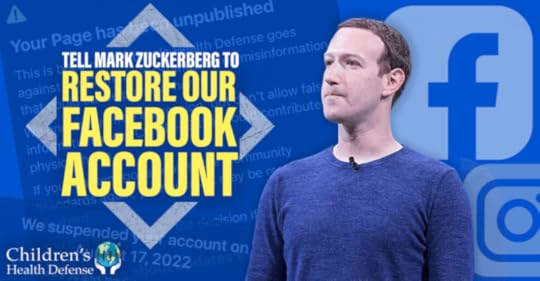
Since August 2022, Children’s Health Defense has been banned from Facebook and Instagram.
For the crime of sharing truthful information and diverse viewpoints — especially related to COVID-19 vaccines, alternative treatments, and vaccine injuries — Meta suddenly and without warning kicked us off both platforms.
SIGN THE PETITIONEven before Meta deplatformed us, CHD sued the social media giant in November 2020, for colluding with the U.S. government to censor and suppress our Facebook and Instagram posts.
After losing our case in the lower courts, we recently petitioned the U.S. Supreme Court to hear our case against Meta.
Less than 24 hours later, Facebook founder Mark Zuckerberg announced he was ending the company’s third-party fact-checking program because it had “gone too far.”
Zuckererg admitted what CHD and others had already verified — that during the pandemic, government officials pressured — or as he told Joe Rogan, “would call up our team and, like, scream at them and curse” at them — to censor content that was factually accurate but didn’t align with the official government narrative.
Meta strangled public debate about life-saving COVID treatments. It even went so far as to prevent people who were injured by COVID vaccines from communicating with each other in private groups.
Now, he says, his company is committed to “restoring free expression.” That’s the right move — but it doesn’t go far enough. It doesn’t undo the damage Meta caused CHD and our social media followers by banishing us from its platforms.
If Mr. Zuckerberg is truly committed to “free expression” he must immediately restore CHD’s Facebook and Instagram accounts. He must also commit to using neutral algorithms that don’t suppress certain content, and to resisting — and publicly reporting — any behind-closed-doors government communications about censoring American’s protected speech.
[…]
How Fukushima’s Radioactive Fallout in Tokyo Concealed from Public

By Francois Diaz-Mauran
Because of the controversy surrounding Satoshi’s paper and the lack of research on the health impacts of these particles, it remains unclear to what extent Tokyo residents have been exposed to dangerous radiation levels as a result of the Fukushima accident.
[…]
Japanese radiochemist Satoshi Utsunomiya found that air samples from March 15, 2011, in Tokyo contained a very high concentration of insoluble cesium microparticles. He immediately realized the implications of the findings for public safety, but his study was kept from publication for years.
On March 14 and 15, 2011—three days after the Great East Japan Earthquake and its resulting tsunami hit the Fukushima nuclear power plant—explosions at two of the plant’s reactor buildings released a huge amount of invisible radioactivity.
[…]
Following the explosions, Japanese researchers rushed to collect and study radioactive materials from the soil and the air to find out what had happened inside the reactors, believed now to have melted down because their cooling systems failed. On March 13, the Tokyo Metropolitan Industrial Technology Research Institute, the agency responsible for measuring the air quality of particulate matter in the Tokyo area, started to collect air samples more frequently. This effort was part of the Tokyo metropolitan government’s emergency monitoring program for environmental radiation, which aimed to detect gamma-emitting nuclides in airborne dust. The filters revealed that at around 10 a.m. on March 15, 2011, a large plume of radioactivity reached Tokyo, some 240 kilometers (149 miles) south of Fukushima. All samples taken on March 14 and March 15 showed spikes in radioactivity.
The institute’s researchers published their first results in the journal of the Japan Radioisotope Association in June 2011 (Nagakawa et al. 2011); they estimated the total exposure dose to humans from radioactive substances, including iodine 131 and cesium 137 found in airborne dust, foodstuffs, and drinking water from the Setagaya ward in the old Tokyo City. Extrapolating from their measurements from March 13 to May 31, they calculated the corresponding annual cumulative dose of radiation in that part of Tokyo as being 425.1 microsieverts, which is less than half the annual dose limit to the public recommended by the International Commission on Radiological Protection. In a second conference publication in English (Nagakawa et al. 2012), the researchers extended their monitoring period to October and estimated that the total annual effective dose due to inhalation for adults in the Tokyo metropolitan area from the Fukushima radioactive plumes was far lower, at 25 microsieverts.
But two years after the accident, Japanese scientists discovered a new type of highly radioactive microparticle in the exclusion zone around the Fukushima plant. The microparticles, which had been ejected from the Fukushima reactors, contained extremely high concentrations of cesium 137—a radioactive element that can cause burns, acute radiation sickness, and even death. Satoshi Utsunomiya, an environmental radiochemist from Kyushu University in southwestern Japan, soon found that these particles were also present in air filter samples collected in Tokyo in the aftermath of the Fukushima accident.
The controversy surrounding his attempts to publish his findings nearly cost him his career and prevented his results from being widely known by the Japanese public ahead of the 2020 Summer Olympics in Tokyo.[1] Scientists still don’t know if these highly radioactive microparticles present significant danger to people, and Satoshi is one of the very few scientists who is focused on trying to find out. “We have the measurements now that tell that the particles did pass over population centers and were being deposited in places,” Gareth Law, a radiochemist from the University of Helsinki, told me. “We should answer the question.”
The discoveryIn May 2012, Toshihiko Ohnuki, an accomplished environmental radiochemist then at the Japan Atomic Energy Agency (JAEA), visited Yoshiyasu Nagakawa at the Tokyo Metropolitan Industrial Technology Research Institute, also known as TIRI. Nagakawa was the first author of two TIRI studies on radiation exposure in Tokyo, and Ohnuki asked Nagakawa if he could obtain some air samples for further analysis. Ohnuki had already studied how radioactive cesium fallout from Fukushima reacted with components of contaminated soil. Now, he wanted to do the same with the airborne dust samples from Tokyo.
Nagakawa gave Ohnuki five small filters that had been collected from the Setagaya ward in old Tokyo City at different times on March 15, 2011—the day the radioactive plume reached Tokyo. Ohnuki received the samples without restriction on their use, and no written agreement was made.[2]
Back in his laboratory at JAEA, Ohnuki performed autoradiography of the five samples, revealing many radioactive spots on all of them. The bulk radioactivity on each sample was measured to be between 300 counts per minute for the filter that covered the midnight to 7 a.m. period and 10,500 counts per minute between 10 a.m. and 11 a.m. on March 15.[3] The radiation rate was so high that Ohnuki had to cut some of the filters into small pieces, less than one square centimeter, to keep from saturating the scanning electron microscope. Ohnuki stored the unexamined filters for future analysis.
Months later, in August 2013, four researchers from the Meteorological Research Institute in Japan reported for the first time about a new type of spherical radioactive cesium-bearing particle that had been ejected in the early days of the Fukushima accident (Adachi et al. 2013). The researchers had collected air samples on quartz fiber filters at their institute in Tsukuba, located 170 kilometers southwest of the Fukushima plant. Their findings, published in Scientific Reports, were about to revolutionize the way environmental radiochemists understood the radioactive fallout from Fukushima.
Back in the lab, the researchers placed the filters on an imaging plate and inserted them into a portable radiography scanner. The images revealed many black dots, which indicated the presence of radioactive materials on the filters, with a maximum radioactivity level measured on the sample at 9:10 a.m. on March 15, 2011, four days after the Fukushima accident began. The researchers placed this sample under a scanning electron microscope and then into an energy-dispersive X-ray spectrometer to directly observe the shape and composition of the radioactive materials on the filters.
[…]
Shocking resultsThe newly discovered entities were initially called spherical cesium-bearing particles, but Satoshi and his co-workers coined the term cesium-rich microparticles, or CsMPs, in 2017, which is now what researchers call them generally (Furuki et al. 2017). CsMPs had not been noted in earlier major reactor accidents.
Scientists knew the microparticles came from the Fukushima reactors because their isotopic ratio between cesium 134 and cesium 137 matched the average ratio for the three damaged reactors calculated by the Oak Ridge National Laboratory.[5] Because these particles emanated from the Fukushima reactors, Satoshi and the other scientists studying them thought that they may contain evidence about reactions that occurred during the accident. But the environmental radiochemist’s curiosity was also triggered by the unique features of these microparticles: Their size is very small, typically two to three microns, even smaller than one micron in some cases.[6] And the cesium concentration in each of the particles is very high relative to their size.
After Satoshi obtained four small pieces of the Tokyo air filters, he designed what he calls “a very simple procedure” to find out whether the filters contained cesium-rich microparticles. In April 2015, he took autoradiograph images of the four pieces, confirming what Ohnuki had already seen with a digital microscope at JAEA. Then Satoshi moved to characterize the structural and chemical properties of the particles using scanning electron microscopy (SEM) and atomic-resolution transmission electron microscopy (TEM). Although the procedure’s design was simple, executing these steps would prove to be extremely difficult.
[…]
Satoshi was now ready to publish his results in a scientific journal. These were important findings that the scientific community needed to know. But Satoshi also understood that they could create a public relations crisis in Japan because his findings contradicted previous statements that played down the implications for public health of Fukushima fallout in Tokyo.
The Goldschmidt Conference—the foremost such international meeting on geochemistry—that year was held in the Japanese city of Yokohama. Satoshi was invited to give a plenary talk and present his research on environmental contamination from the Fukushima disaster (Utsunomiya 2016). During the talk, he presented his new findings on the Tokyo air filters. His talk received a lot of attention and was even reported by several Japanese and international newspapers. After his presentation, the scientific chair of the conference, Hisayoshi Yurimoto, said: “Very interesting results. And also very shocking results.”[1
In April and June 2016, Satoshi conducted dissolution experiments and quickly confirmed that the CsMPs were insoluble in water. The experiments also showed that most of the cesium activity on these filters came from CsMPs. In fact, up to 90 percent of the cesium radioactivity came from these microparticles, not from soluble forms of cesium—meaning that most of the cesium radioactivity detected during the March 15 plume in Tokyo was from CsMPs.
Between 2016 and 2019, a Kafkaesque sequence of events circled about Ohnuki, the former JAEA researcher who gave Satoshi the Tokyo air filter samples, and Satoshi. During that sequence of events, Satoshi’s research paper was accepted for publication by a prestigious scientific journal after peer review—but the journal delayed publication of the paper for years, eventually deciding not to publish it based on mysterious accusations of misconduct that, it turned out, were unwarranted.
As a result, Satoshi’s findings were not made widely known, saving the Japanese authorities a possible public relations crisis as the summer Olympics in Tokyo neared. Because of the controversy surrounding Satoshi’s paper and the lack of research on the health impacts of these particles, it remains unclear to what extent Tokyo residents have been exposed to dangerous radiation levels as a result of the Fukushima accident.
[…]
In October, as Ohnuki dealt with insistent requests that he return the filter samples, Satoshi submitted two research manuscripts to the journal Scientific Reports, one on the first successful isotopic analysis of individual cesium-rich microparticles based on soil samples collected from the exclusion zone at Fukushima, and one on the first characterization of the CsMPs from the Tokyo air filter samples that he had presented during his talk in Yokohama. Both articles were accepted in early January 2017 after peer review.[11]
The Tokyo paper, titled “Caesium fallout in Tokyo on 15th March, 2011 is dominated by highly radioactive, caesium-rich microparticles,” was co-authored by three graduate students from Satoshi’s lab—Jumpei Imoto, Genki Furuki, and Asumi Ochiai, who conducted the experiments—and three Japanese collaborators: Shinya Yamasaki from the University of Tsukuba who contributed to the measurement of samples; Kenji Nanba of Fukushima University, who contributed to the collection of samples; and Toshihiko Ohnuki, who had obtained the samples. The paper included two international collaborators who were world experts in the study of radioactive materials, Bernd Grambow of the French National Center for Scientific Research at the University of Nantes in France and Rodney C. Ewing of Stanford University, who contributed to the research ideas and participated in the analysis of the data. Satoshi was the lead author of the study.
[…]
On the day of the visit, Moriguchi sent an e-mail to Ohnuki, pressing him to inform TIRI about the planned publication. “This type of information makes government agencies very sensitive,” Moriguchi wrote. “If the results obtained from these valuable sample collections conducted at a research institute under the administration were to incur the displeasure of government agencies and it becomes difficult to obtain cooperation from research institutions, we are concerned that this could hinder future research using these types of samples.”
[…]
Almost immediately, Sakurai moved to block the publication, according to e-mails obtained by the Bulletin.
[…]
In July 2017, TIRI increased the pressure by sending a formal complaint to the Tokyo Institute of Technology, where Ohnuki was now employed. In a letter that the researchers were not able to see until a year after it was sent, TIRI accused Ohnuki of “suspected acts violating internal regulations, researcher’s ethics and code of conduct” in providing Satoshi with samples from TIRI without the institute’s consent.
[…]
In June 2019, Satoshi and his co-authors posted their paper on arXiv (Utsunomiya et al. 2019), thereby making the findings public—two-and-a-half years after its acceptance by Scientific Reports.
[…]
Gates Foundation Tax-Exempt Status Faces Court Challenge Over Vaccine Profits

By broken truth.tv
MIAMI, FL — In a legal confrontation with potential far-reaching implications, Floridian and head of The World Peace Through Education Foundation, Inc, William S. Scott has filed an appeal and petition for a Writ of Mandamus against the Internal Revenue Service (IRS) in the United States District Court for the Southern District of Florida, targeting the Bill and Melinda Gates Foundation/Trust (BMGF/Trust).
The appeal, case number 1:24-cv-24123-CMA (filing at end of article), is set before Chief Judge Cecilia Altonaga, the first Female Cuban American Federal Judge, who presides over the United States District Court for the Southern District of Florida. Her ruling on this appeal is anticipated in the coming days, adding to the urgency surrounding this case.
Scott’s legal action follows the IRS’s rejection of his whistleblower claim on September 26, 2024. He alleges that the foundation has been engaged in for-profit activities under the guise of charity, stating, “Under the pretense of improving World Health, Bill & Melinda Gates Foundation/Trust has been engaged in the promotion, manufacture and sale of Covid-19 vaccines that were not sufficiently tested for safety or for effectiveness for their intended use.” He further asserts, “The claim that its efforts are charity are bogus and it has acted in bad faith.”
Since its founding in 2000, the Bill and Melinda Gates Foundation has been a leader in global health, reporting tax-exempt revenue of $6,840,102,370 in 2023. Among its significant investments, the foundation provided $55 million to BioNTech in 2019 for vaccine development (source).
Global Scrutiny and Legal Challenges: The foundation is under scrutiny not just in the U.S. but also internationally. Kenya’s High Court has suspended the Gates Foundation’s diplomatic immunity due to accountability concerns. This scrutiny extends to countries like the Netherlands, where there are discussions or legal preparations against the foundation’s international operations.
Adding complexity to this narrative, Margaret Hamburg, who served as FDA Chairman from 2009 to 2015, now sits on the Gates Foundation’s Global Health Scientific Advisory Committee (link to her position on the committee). Her husband, Peter Brown, leads Renaissance Technologies, known for its investments in medical stocks. This is underscored by Renaissance Technologies’ $7 billion settlement with the IRS in 2021 over tax strategies.
Implications of Losing Tax-Exempt Status:The revocation of the Gates Foundation’s tax-exempt status would have profound consequences:
Tax Liability: An estimated annual federal tax of $1.44 billion for 2023, based on a 21% corporate rate, not including state taxes or penalties for prior years.Donation Deductibility: The loss of tax deductions could significantly impact donation levels.Operational Adjustments: The foundation might need to scale back or alter its charitable operations.Wealth Loss Estimation: An immediate annual financial hit over $1 billion, with long-term impacts on its endowment.Public Perception and Legal Ramifications: Public trust could wane, potentially leading to further legal scrutiny.Comparison to Blue Shield’s Case: Blue Shield of California’s 2015 loss of state tax-exempt status provides a cautionary tale, where operational concerns led to significant changes. This could be a foreshadowing for the Gates Foundation if it faces similar challenges.
Legal Precedents: Shows the potential for a reassessment of tax exemptions.Public and Regulatory Reaction: Similar backlash might be expected.Operational Impact: Operational strategies would likely need reevaluation.Influence of Donors on Scientific Research: Influential donors like the Gates Foundation can skew research priorities, potentially prioritizing commercial interests over public health needs, leading to:
Bias in Research Focus: Funding might lean towards areas beneficial to the donor’s interests.Conflict of Interest: Research impartiality can be compromised.Impact on Public Trust: Skepticism can grow regarding the integrity of funded research.This is particularly relevant in the context of clinical trial research, where transparency is crucial. The Association of Clinical Research Professionals (ACRP) advocates for researchers to disclose relationships and potential conflicts of interest publicly, but this directive is not always followed, leading to potential biases or misrepresentations in research outcomes. Studies have shown that a significant percentage of clinical trial reports might fail to disclose conflicts of interest:
A 2016 review published in “Research Integrity and Peer Review” determined that between 43% and 69% of research study reports failed to disclose conflicts of interest (source).A study in the “Journal of the American Medical Association (JAMA)” reported that approximately 32% of clinical trial authors had not fully disclosed their industry payments in their articles (source).In the “BMJ Evidence-Based Medicine,” a study published in 2020 discussed the complexities of conflicts of interest in medical research, noting that many clinical trials and their authors have industry ties which are not always transparently reported (source).Another study from the “BMJ” in 2014, analyzing newspaper articles about the H1N1 pandemic, found that academics with financial ties to drug companies selling related medications rated the health risks significantly higher than those without such ties, suggesting a potential bias in reporting due to undisclosed conflicts (source).A cross-sectional study published in “BMJ” in 2017 found evidence of high rates of underreporting of financial conflicts of interest among clinical investigators (source).According to Scott’s petition, the IRS did not conduct an investigation into the Gates Foundation’s activities based on his whistleblower claim. Scott asserts, “Petitioner believes, and therefore asserts, that the IRS conducted no investigation to reach its decision to deny his Form 211,” highlighting a key point of contention in this legal battle.
Gates Foundation’s Funding in Pro-Vaccine Organizations:
The Gates Foundation has been a significant financier in the pro-vaccine landscape, supporting numerous organizations:
Gavi, the Vaccine Alliance: The foundation initially funded Gavi with $750 million in 2000 to enhance vaccine access in developing countries. By 2020, the Gates Foundation pledged $1.6 billion for Gavi’s next strategic period, focusing on equitable vaccine distribution (source).Coalition for Epidemic Preparedness Innovations (CEPI): In November 2020, the Gates Foundation committed an additional $20 million to CEPI for advancing research on COVID-19 vaccines. This followed a $50 million contribution to CEPI’s COVAX Advance Market Commitment in June 2020 (source).PATH: The foundation has invested in PATH’s efforts in vaccine development, notably contributing to the introduction of the rotavirus vaccine in developing countries. The exact amounts are not consistently public, but these efforts have been part of larger commitments to global health.World Health Organization (WHO): The Gates Foundation has provided funding to WHO for various health initiatives, including vaccine programs, though specific figures for vaccine-related funding are less delineated but known to be substantial.Novavax: In 2015, the Gates Foundation awarded Novavax a $89 million grant to develop a vaccine against respiratory syncytial virus (RSV) (source).Concerns Over Federal Agency Oversight and Robert F. Kennedy Jr.’s Confirmation: Amid these legal and operational challenges, there’s growing public concern over federal agencies potentially ignoring or omitting reports of injuries related to the COVID-19 vaccines. This sentiment is fueled by posts on social media platforms like X, where users have expressed frustration over the lack of acknowledgment or investigation into alleged vaccine injuries. This has led to calls for more rigorous scrutiny of vaccine research and safety data ().
Adding to this debate is the looming confirmation of Robert F. Kennedy Jr. as head of the Department of Health and Human Services (HHS). Known for his skepticism towards vaccines, Kennedy has promised to revisit federal vaccine recommendations, emphasizing the need for transparency and safety in vaccine research. His potential confirmation has sparked a polarized response, with some seeing it as an opportunity to critically assess the vaccine safety and efficacy processes, while others fear it might undermine public health efforts (source, source, source).
This legal challenge by Scott not only questions the Gates Foundation’s accountability but also highlights the broader issues of transparency, influence, and the need for more rigorous oversight in both philanthropy and public health research. The outcome of these legal and political developments could significantly influence how tax-exempt statuses are managed, how donor influence is perceived, and the enforcement of disclosure policies in scientific research globally.
[…]
Via https://www.brokentruth.tv/p/bill-gates-foundation-faces-court
Studies You’re Not Meant to See Linking Vaccines to Autism

Dr Eddy Betterman
In recent years, the incidence of autism has skyrocketed among children, with some parents seeing a rapid decline in responsiveness, speech and cognitive abilities after their child receives a series of vaccines. The most terrifying suspect in this public health crisis is the medical establishment’s blind faith in vaccines. For years, medical professionals have repeatedly claimed that vaccines do not cause autism. This blind faith is not backed up by the scientific literature, however. Vaccines are known to contain neurotoxic substances such as mercury and aluminum, and studies continue to show how this leads to brain damage in children.
Hepatitis B vaccines and the thimerosal-autism connection:One particularly alarming study, published in the journal Neural Development, evaluated the relationship between Thimerosal-containing vaccines and autism diagnoses. Thimerosal, a compound that contains nearly 50% mercury by weight, has been extensively used as a preservative in various vaccines. The study, conducted in two phases, observed a significantly increased risk ratio for the incidence of autism spectrum disorder (ASD) following vaccinations containing Thimerosal. A hypothesis-generating and hypothesis-testing study design confirmed that children exposed to Thimerosal in hepatitis B vaccines had a greater likelihood of developing ASD, highlighting the possible link between Thimerosal exposure and autism.
Speech impairments linked to increase in vaccination ratesAnother study, published in the Journal of Toxicology, found a positive and statistically significant association between the proportion of children receiving recommended vaccinations and the prevalence of autism or speech and language impairments (Source 2). The analysis showed that for every 1% increase in vaccination rates, an additional 680 children per state were diagnosed with autism or speech and language impairments. This correlation raises serious concerns about the potential role of vaccines in the development of autism.
Aluminum adjuvant’s connection to brain damage and autism diagnosisIn addition to the possible role of mercury, other studies have pointed to aluminum as a potential culprit. A study published in Journal of Inorganic Biochemistry applied Hill’s criteria to investigate whether exposure to aluminum adjuvants in vaccines could contribute to the rising prevalence of autism. The findings showed that countries with the highest exposure to aluminum adjuvants in vaccines also had the highest prevalence of ASD. Furthermore, a significant correlation was found between the amount of aluminum in the vaccines and the current prevalence of ASD in seven Western countries, particularly at the 3-4-month mark, when many vaccines are administered.
MMR antibodies and central nervous system autoimmunityMoreover, there is evidence suggesting a connection between the measles, mumps, and rubella (MMR) vaccine and autism. A study published in the Journal of Child and Adolescent Psychopharmacology found that autistic children harbored elevated levels of MMR antibodies and had a strong association between MMR antibodies and myelin basic protein (MBP) auto antibodies, which are linked to central nervous system autoimmunity.
Autism more prevalent in certain ethnic groups exposed to Hep B vaccinesThe impact of vaccines on male neonates is also of concern. A study published in Neuropsychiatric Disease and Treatment showed that U.S. male neonates vaccinated with the hepatitis B vaccine prior to 1999 had a threefold higher risk for autism diagnosis compared to boys not vaccinated during that period. Moreover, non-white boys were found to be at a greater risk. This suggests that the effects of vaccines on different ethnic groups may vary, and further research is necessary to understand these differences.
Over-vaccination and DNA alterationsThe potential link between vaccines and autism has sparked intense debate, with many parents and scientists questioning the safety of the current vaccine schedule. The expression of systemic failure, sensory dysfunction, and autoimmune issues in children diagnosed with regressive autism raises the question of whether these symptoms are the result of subtle DNA alterations caused by the overuse of vaccines, as explained in a study published in the North American Journal of Medical Sciences.
The scientific evidence linking vaccines to autism cannot be ignored. As research continues to emerge, it is becoming increasingly clear that further investigation into the safety and long-term effects of vaccines is critical. The potential risks associated with their ingredients must be thoroughly examined to ensure the well-being of future generations.
[…]
Via https://dreddymd.com/2025/01/13/studies-link-vaccines-to-autism/
January 13, 2025
Connecticut Sen Anwar Proposes Bill To Requiring Permits to Spray Chemtrails

Connecticut Central
Remember when Bobby Kennedy seemed to suggest “chemtrails” were real when he responded to an X post in August, and promised to “stop this crime”? And that time he interviewed Dane Wigington in 2023 to find out what research existed to back up “chemtrails”?
Remember the beating Kennedy took in the mainstream media (here, here, here) for promoting a so-called conspiracy theory? See https://x.com/i/status/1827992555637608614
Well, the “chemtrail” crowd has been saying “told ya so” ever since learning Connecticut State Senator Saud Anwar sponsored Proposed Bill 417, An Act Concerning Permit Requirements for Cloud Seeding Activities in the State.
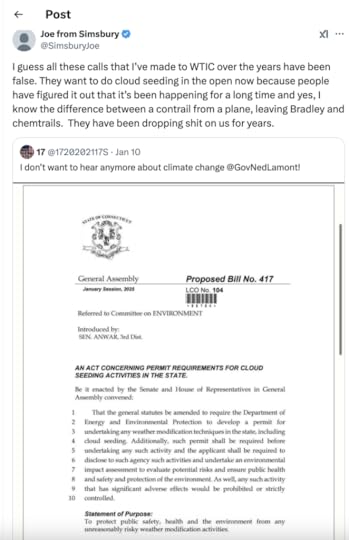 Screenshot, X
Screenshot, XThe bill proposes the general statutes be amended to require the Department of Energy and Environmental Protection to develop a permit for undertaking any weather modification techniques employed in the state, and that includes cloud seeding.
Plus, an environmental impact assessment will be required to evaluate risks and ensure that public safety, health, and the environment are protected from any unreasonably risky weather modification activities.
Weather modification includes “any activity performed with the intention of producing artificial changes in the composition, behavior, or dynamics of the atmosphere” according to NOAA.
Currently, NOAA states that cloud seeding is the only ‘common‘ weather modification activity practiced in the U.S., common being the operative word.
It’s usually done by private companies in west mountain basins during winter to help build up snowpack, or in the desert southwest to fill water reservoirs during summer. Sometimes airlines use a type of seeding to disperse fog called “glaciogenic seeding.”
Why cloud seeing hasn’t been used to help dampen the California wildfires is a different issue.
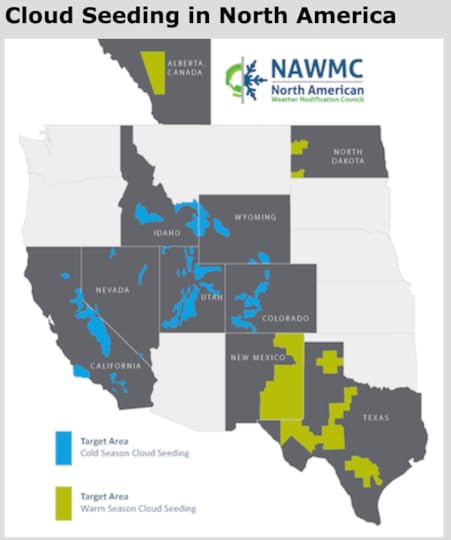 Screenshot, North American Weather Modification Council
Screenshot, North American Weather Modification CouncilIt’s also worth mentioning that back in 2022, the Biden Administration’s Consolidated Appropriations Act directed the Office of Science and Technology Policy (OSTP), with support from NOAA, to provide a research plan for “solar and other rapid climate interventions” that could help address “climate change.”
The resulting July 2023 research document focused on atmospheric-based approaches to solar radiation modification (SRM), specifically stratospheric aerosol injection (SAI) and marine cloud brightening (MCB). The report also mentions cirrus cloud thinning (CCT).
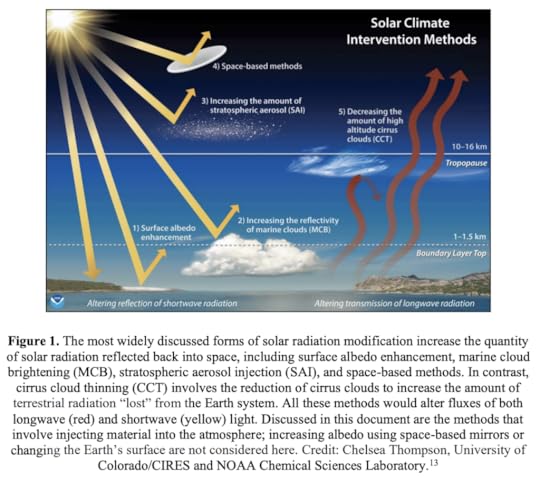 Screenshot, White House June 2023 Research Plan
Screenshot, White House June 2023 Research PlanSAI was originally proposed in 1977 as a method to allegedly “tackle the impacts of global warming” by reflecting some of the sun’s rays away from Earth. The approach “aims to mimic the planet cooling effects of volcanic eruptions by injecting sulfur dioxide (SO2) directly into the stratosphere where it forms sunlight-reflecting sulfate aerosols.”
MCB involves the “injection of salt spray into shallow marine clouds to brighten them, increasing their reflection of sunlight and reducing the amount of heat absorbed by the water below.”
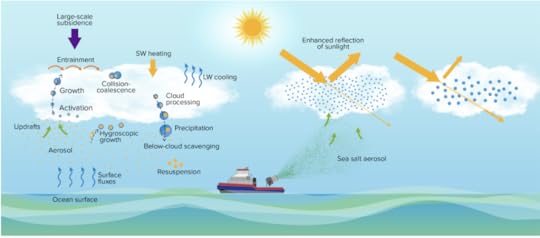 Screenshot, NOAA Research
Screenshot, NOAA ResearchNOAA is even offering a 2025 grant for “Integrating Observations and Modeling in Support of Process Understanding Relevant to Solar Radiation Modification Research,” indicating the government’s continued interest in weather modification.
But rather than working to create a permit process for those wishing to engage in unproven and potentially risky weather modification techniques in Connecticut, reasonable people in the state wonder why not just ban weather engineering altogether like Tennessee did?
Toward that end, the folks at Zero Geoengineering have put together a letter you can automatically send to legislators to urge them to ban weather modification practices, and they also maintain a state-specific page for Connecticut with some interesting information.
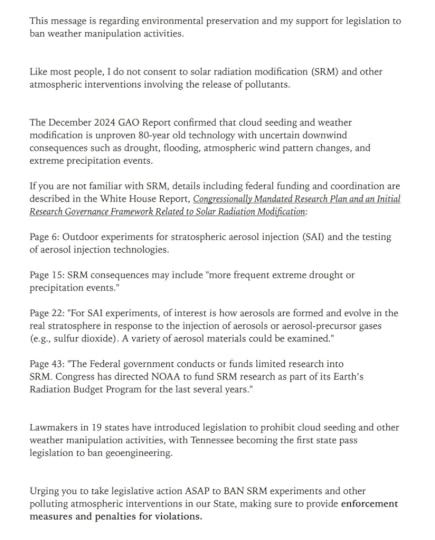 Screenshot, ZeroGeoengineering.com Letter for Legislators
Screenshot, ZeroGeoengineering.com Letter for Legislators[…]Via https://connecticutcentinal.com/you-thought-it-was-just-a-conspiracy-theory-well-connecticut-sen-anwar-proposed-a-bill-to-require-permits-for-cloud-seeding-and-weather-modification/
The Most Revolutionary Act
- Stuart Jeanne Bramhall's profile
- 11 followers




